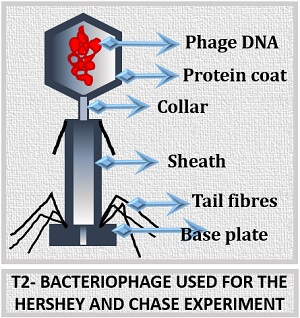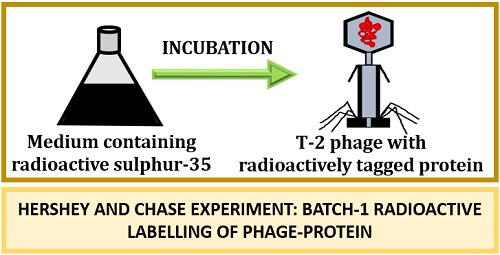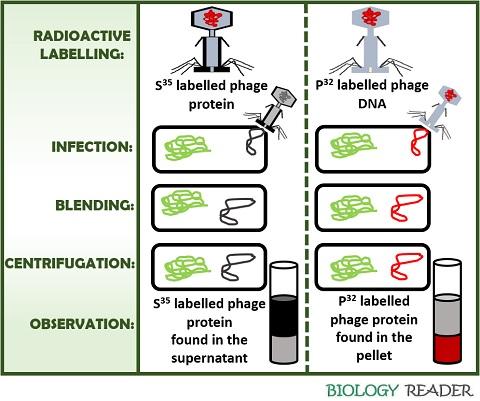Hershey and Chase experiment give practical evidence in the year 1952 of DNA as genetic material using radioactive bacteriophage. Griffith also explained the transformation in bacteria and concluded that the protein factor imparts virulence to the rough strain, but it was not proved to be genetic material.
Avery, Macleod and McCarthy further studied the Griffith experiment and concluded that the DNA was the genetic material responsible for transforming the avirulent rough strain to the virulent strain. To resolve the query of genetic material, many researchers were engaged to know whether the cause of inheritance is protein or DNA.
Many assessments then led to the discovery of “DNA” as genetic material or the cause of inheritance. One of the best experiments that provide DNA evidence as genetic material is the “Hershey and Chase experiment”. We will study the definition, steps (radioactive labelling, infection, blending and centrifugation) and observation of the Hershey and Chase experiment in this context.
Content: Hershey and Chase Experiment
Definition of Hershey and Chase Experiment
Hershey and Chase’s experiment has demonstrated the DNA is the genetic material where they have taken the radioactive T2-bacteriophage (Viruses that infect E.coli bacteria). T2-bacteriophage or Enterobacteria phage T2 belongs to the Group-I bacteriophage.
The genome of the T2-bacteriophage comprises linear, ds-DNA and they are a part of the Myoviridae family. The body of the T2-bacteriophage basically comprises of three parts, namely the head, collar and tail. T2-bacteriophage resembles the T4-like virus or T4-bacteriophage because of the tailed phage.

In the Hershey and Chase Experiment, the phage DNA and protein were labelled with radioactive phosphorus (P32) and radioactive sulphur (S35), respectively to know whether phage DNA or protein will infect the E.coli. After labelling the Phage DNA and protein, Hershey and Chase performed a series of experiments like infection, blending and centrifugation.
Video: Hershey and Chase Experiment
Hershey and Chase Experiment Steps
Hershey and Chase gave full evidence of the DNA being a genetic material by their experiments. To perform the experiment, Hershey and Chase have taken T-2 bacteriophages (invaders of E.coli bacteria). The experiment includes the following steps:
Radioactive Labelling of Bacteriophage
Hershey and Chase have grown T-2 bacteriophages in the two batches. In batch-1, we need to grow the bacteriophages in the medium containing radioactive sulphur (S35) and radioactive phosphorus (P32) in batch-2. After incubation, we could see that the radioactive sulphur (S35) will tag the phage protein. The radioactive phosphorus (P32) will tag the phage DNA.
Now there will be a question of why radioactive sulphur has labelled only the phage protein, not DNA. The labelling of phage protein by S35 is because sulphur being a structural element of protein will tag the Phage protein, not the phage DNA.

Conversely, the labelling of phage DNA by P32 is because phosphorus constitutes the backbone of DNA so it will tag the Phage DNA, not the phage protein.

Infection
After radioactive labelling of the phage DNA and protein, Hershey and Chase infected the bacteria, i.e. E.coli by using the radioactively labelled T-2 phage. In batch-1, T-2 phage tagged with S35 and in batch-2 T-2 phage labelled with P32 were allowed to infect the bacterial cells of E.coli.
After the attachment of T-2 bacteriophage to the E.coli, the phage DNA will enter the cytoplasm of E.coli. The phage DNA will take up the host cell machinery. Degradation of the bacterial genome occurs by the T2-phages where they use the ribosomes to form structural proteins of the capsid, tail fibres, base plate etc.
Blending
At the time of blending or agitation, the bacterial cells are agitated to remove the viral coats. As a result of the agitation, we get a solution containing bacterial cells and viral particles like capsid, tail fibres, base plate, DNA etc.
Centrifugation
This stage separates the viral particles and bacterial cells from the above solution. As a result of centrifugation, the heavier particles, i.e. bacterial cells, will deposit in the form of “Pellets”. The lighter particle, i.e. viral particles, will appear in the “Supernatant” of the solution.
Observation
After the centrifugation, we could observe the results to identify the heritable factor. The phage DNA labelled with P32 will transfer the radioactivity in the host cell. Thus, the radioactive P32 enters a bacterial cell and exists in the form of “Pellets”. The phage protein tagged with S35 will not transfer its radioactivity in the host cell. As a result, radioactive S35 will appear in the form of “Supernatant” in the solution.
Conclusion
The P32 labelled phage DNA will transfer its radioactivity to the host cell DNA, while S35 labelled phage protein will not do so. The P32 labelled phage DNA will remain inside the E.coli cell even after blending and centrifugation. According to the Hershey and Chase experiment, we can conclude that the DNA is the genetic material because the P32 tagged T2-phage DNA will transfer the radioactivity to the host cell (E.coli) not the S35 labelled T2-phage protein.